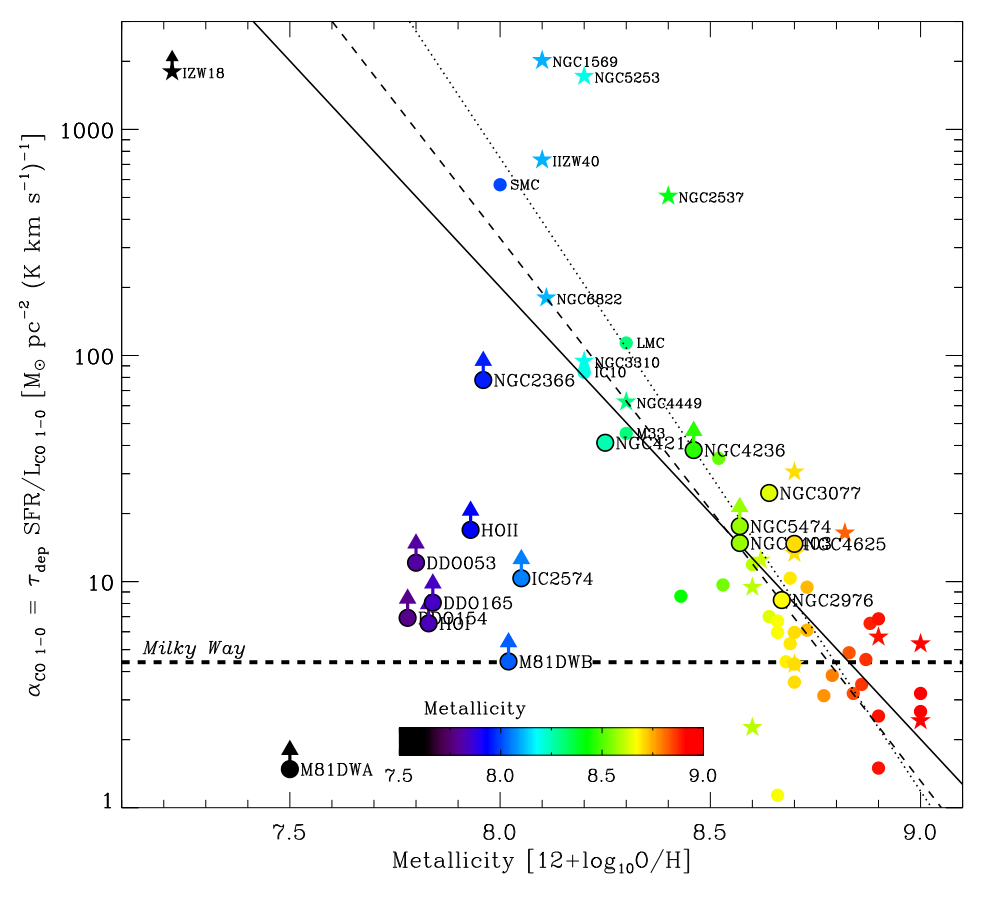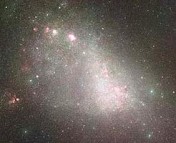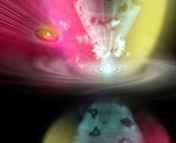- Title: Low CO Luminosities in Dwarf Galaxies
- Authors: Andreas Schruba et al., Adam K. Leroy, Fabian Walter, Frank Bigiel, Elias Brinks, W. J. G. de Blok, Carsten Kramer, Erik Rosolowsky, Karin Sandstrom, Karl Schuster, Antonio Usero, Axel Weiss, Helmut Weisemeyer
- First Authors’ Institution: Max-Planck-Institut für Astronomie, Heidelberg
How do we infer the presence of molecular gas in distant galaxies?
It’s an unpleasant fact of galactic astronomy that most of the molecular gas in nearby galaxies is completely undetectable. The trouble lies with the most abundant molecular species: H2. Molecular hydrogen is unfortunately an extremely poor radiator due to the symmetry of the molecule and its extremely low mean molecular weight. The low molecular weight implies that the spacing between rotational levels of the molecule is wide: in temperature units, the energy of the first transition lies 171 Kelvin above the ground state. Unfortunately, the transition from the first excited state to the ground state is strongly forbidden due to the symmetry of the hydrogen molecule: molecular hydrogen has no permanent electric dipole moment. Taken together, this means that molecular hydrogen will not emit appreciably unless the ambient temperature is of order a few hundred Kelvin. Since molecular clouds can cool effectively to very low temperatures, only a few tens of Kelvin, the probability of directly detecting emission from the bulk of the molecular gas in galaxies is pretty much nil.

A CO emission map of a a giant molecular cloud in the Large Magellanic Cloud (adapted from Hughes et al. 2010).
For this reason, astronomers usually use the next most abundant molecule in molecular clouds, carbon monoxide, as a tracer for the bulk of the molecular gas. Since CO has a higher mean molecular weight, the first rotational excited state of CO lies only 5.5 Kelvin off ground. Even better, this transition is allowed since CO possesses a permanent dipole moment. Thus, in typical molecular cloud conditions, one expects to detect significant carbon monoxide emission. Indeed, CO emission is found in many galaxies, even galaxies at cosmological distances. Unfortunately, using CO to estimate the total molecular mass introduces a large source of systematic error: the conversion factor between CO luminosity and H2 mass.
The conversion factor is troubling because CO is inherently more fragile to the destructive ultraviolet radiation field that permeates galaxies. Since H2 is so abundant, it can self-shield: molecular hydrogen molecules at the surfaces of molecular clouds can absorb all of the dissociating photons, leaving molecules in the interior free to go about their business. CO is far less abundant, so it cannot self-shield. Instead, CO is protected from dissociation by dust grains which absorb the CO-dissociating photons before they can reach a CO molecule. However, the amount of dust in a galaxy scales linearly with metallicity, implying that CO is more easily dissociated in low metallicity systems, producing lower equilibrium CO abundances per unit mass of molecular gas. This is particularly troubling because expensive new telescopes (e.g. ALMA) and instruments (e.g. the EVLA) are being designed to detect CO emission at cosmological distances. CO will probably be our only direct tracer of the bulk of the gas in high-redshift systems, so if the CO abundance is sensitive to metallicity, it is imperative that we have an empirical and theoretical understanding of the nature of CO emission.
A search for CO in dwarf galaxies
Today I’ll be summarizing a new observational paper on this topic. Andreas Schruba and collaborators use a stacking analysis to detect emission from the CO molecule in nearby metal-poor dwarf galaxies. This is based on data from the HERACLES survey: a survey for CO emission in nearby galaxies using the HERA receiver on the IRAM 30-meter submillimeter telescope in the French Alps. While the survey detected significant CO emission in nearby massive galaxies, several nearby dwarf galaxies did not show significant emission in any individual IRAM pointing. However, since IRAM resolved these galaxies with many individual pointings, it’s possible that some low level of CO might possibly be recovered by adding up the exposures for an entire galaxy, beting down the noise present in any one measurement.

Left two columns: the CO maps for a selection of dwarf galaxies observed by HERACLES. Where present, the white ellipses indicate the size of the galaxy in optical starlight and the black contours indicate the extraction region for the stacking analysis. Only a few galaxies show CO emission in individual IRAM pointings. The right two columns show the stacked CO spectrum. The red data points are fitted with a gaussian. Solid and dotted green lines indicate the fit; solied lines are statistically significant fits while dotted lines indicate nondetections. The stacking analysis did not yield any additional detections.
The results of this exercise are shown above. While some of the dwarf galaxies show CO emission in individual IRAM pointings, many show no detectable emission in any single pointing. Unfortunately, the coadded CO spectra do not yield any additional CO detections. While two of the galaxies show tantalizing peaks near the expected location of the CO line, the emission in these systems is not statistically significant. This result is perhaps not surprising. The Small Magellanic Cloud, the lowest metallicity system for which we have secure CO detections, would not be visible in CO in an IRAM observation at the distance of the HERACLES galaxies. Unperturbed by the null result, the authors go ahead and set upper limits for the CO luminosity for the galaxies with no secure CO detections. Including these upper limits in a larger sample of literature results, they then attempt to derive the dependence on metallicity of the CO to H2 conversion factor.

The CO to molecular hydrogen conversion factor plotted as a function of metallicity. The dotted line indicates the value measured in the Milky Way by measuring gamma-rays produced by collisions between molecular hydrogen and cosmic rays.
Unfortunately, to derive the CO to H2 conversion factor, the authors would need to somehow directly measure the H2 mass, a futile exercise. Instead, they merely estimate the H2 mass by taking advantage of the observed linear correlation between gas surface density and star formation rate surface density – implying a constant time to deplete the gas present in any given galaxy. In other words, an observer can measure the star formation rate and infer the gas mass by assuming that the gas will be consumed in the universal gas depletion time. This assumption may not hold, particularly for starburst systems which may be undergoing interactions with other galaxies, and is probably the largest source of systematic error in the analysis. Keeping this caveat in mind, it’s still interesting to take a look at the CO to H2 conversion factor as a function of metallicity. The results of this calculation are shown below. It seems very clear that, per unit mass of molecular gas, low metallicity systems produce hundreds of times less CO emission compared to systems that are more rich in metals. This poses a challenge for observations of molecular gas in metal-poor galaxies. This problem is worse at high redshift, since metal-poor galaxies were the norm in early epochs of the universe. It seems that some other tracer of molecular gas must be developed that is not so sensitive to metallicity. Future observations of atomic gas from the Square Kilometer Array, C+ emission in the far infrared, or observations of molecules like NH3 or HCN may be better direct tracers of gas in low metallicity systems.





Trackbacks/Pingbacks